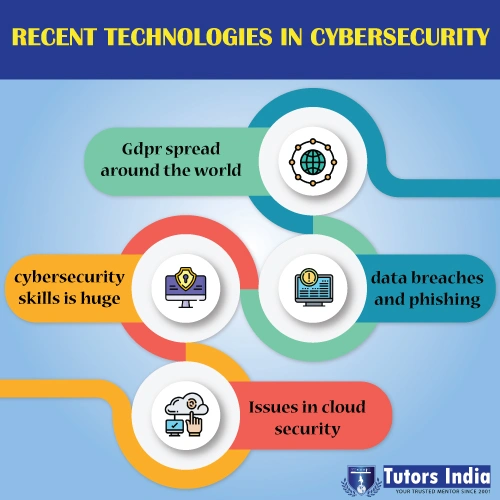Recent Technologies In Cybersecurity
Introduction:
As digital gadgets ruling the globe, a massive amount of data generating per second is unimaginable. Manipulating and handling the data by data specialists and data scientist is the huge process. Processing the data and concluding the required results is vital. But providing data security in the vulnerable world becomes a tedious one. As we are vulnerable in the digital era, protecting us from the vulnerabilities is cannot manageable. This blog will enhance the scope and need for Cybersecurity in the statistical and analytical arena. [1]

Recent Technologies In Cybersecurity:
As the threats and risks in the cyber world is rapidly increasing, to assess those threats and risks through certain new technologies. Those technologies can be accessed by Whitehat cybersecurity specialists who provide security for the users and data.
1. gdpr spread around the world:
Personal information must be a high priority for online companies. With the increasing number of data leaks, ignoring data privacy issues is becoming more difficult. [2]
- Individuals must be aware of how businesses can use their personal information.
- Data encryption that is both strong and reliable is a must.
- They should be able to opt-out of sharing their personal information.
- Companies must notify their customers of data breaches within a certain amount of time when they occur.
2. data breaches and phishing:
One of the most important developments in Cybersecurity is the prevention of phishing attacks. It’s been on the radar of cybersecurity trends for quite some time and isn’t going anywhere anytime soon.
Victims are often being duped into turning over sensitive information, various types of passwords (such as a login), and sending money directly to cybercriminals. SMS, chats on social media sites like Facebook or LinkedIn, and phone calls involving a real human are among the other exponentially increasing phishing platforms. [3]
3. cybersecurity skills is huge:
The market for cybersecurity experts would outnumber availability by a factor of ten. Another reason to be concerned about this cybersecurity development is the growing amount of threats that security teams must deal with on a daily basis. [4]
Using automatic security systems is one way to get out of this situation.
Such well-known data protection techniques are as follows:

Bricata
BluVector
Cloud Defender
Cofense Triage
[Looking for the latest Computer Science Research Topic ideas Mail us at info@tutorsindia.com]
4. issues in cloud security:
Every bit of records and nearly all business processes and technology have been migrated to the cloud. If the number of cloud-related threats grows, cloud defence becomes another ambitious development in the cybersecurity industry. [5]
Data breaches pose a threat to SMBs and businesses alike, due to improperly encrypted data and unauthorised services that end-users can quickly instal.
Future Scope:
1. Hardware authentication: Hardware authentication is the way of the future when it comes to cryptography. This user authentication method is based on a computer, such as a smartphone, laptop, or some other hardware machine owned by an authenticated user. This method may be in the form of a simple password or fingerprints to access the computer. [6]
2. Artificial Intelligence and Machine Learning: AI is described as a technology that attempts to mimic human performance by learning, concluding, interpreting complex information, conversing naturally with people, improving human cognitive performance, and, most importantly, replacing humans in the execution of non-routine tasks.
3. Adaptive Neural Networks:
Automated networks have the potential to transform the world of Cybersecurity. Scanning and tracking of linked networks can be automated, and deviations and disturbances can be reported real-time. Network, endpoint, firewalls, payload, and anti-virus protection system layers are automatically modified, as well as diagnostic and forensics review for Cybersecurity. AI and machine learning maybe some of the most important elements.
References:
1. Obaidat, Mohammad S., Issa Traore, and Isaac Woungang, eds. Biometric-based physical and Cybersecurity systems. Cham: Springer International Publishing, 2019.
2. Lu, Yang, and Li Da Xu. “Internet of Things (IoT) cybersecurity research: A review of current research topics.” IEEE Internet of Things Journal 6.2 (2018): 2103-2115.
3. Asghar, Muhammad Rizwan, Qinwen Hu, and Sherali Zeadally. “Cybersecurity in industrial control systems: Issues, technologies, and challenges.” Computer Networks 165 (2019): 106946.
4. Geluvaraj, B., P. M. Satwik, and TA Ashok Kumar. “The future of cybersecurity: Major role of artificial intelligence, machine learning, and deep learning in cyberspace.” International Conference on Computer Networks and Communication Technologies. Springer, Singapore, 2019.
5. West, Jason. “A prediction model framework for cyber-attacks to precision agriculture technologies.” Journal of Agricultural & Food Information 19.4 (2018): 307-330.
6. Toch, Eran, et al. “The privacy implications of cyber security systems: A technological survey.” ACM Computing Surveys (CSUR) 51.2 (2018): 1-27.

 Next Post
Next Post